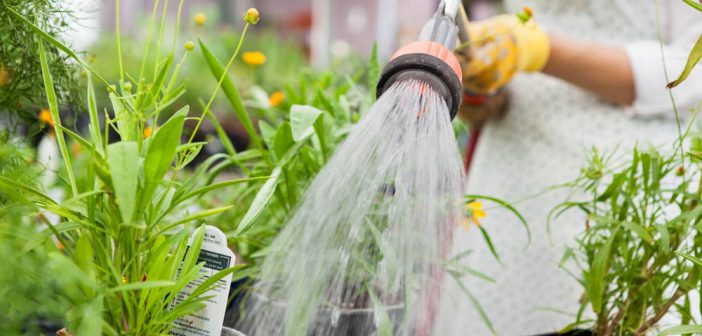With the hot summer months coming up, gardeners and landscapers are getting ready to keep up with the demands of thirstier plants. The summer months always require a little bit more water care, and the new workload may seem especially overwhelming for those who are just learning about the ins and outs of their garden. Whether you are introducing new plants to your vista or are simply interested in optimizing your existing water care routine, it always pays to keep a few tips in mind. Think about some of these considerations you can make to watering easy and efficient.
Choose by Touch
Perhaps one of the oldest watering tricks to remember is to touch the soil for moisture. When you water by hand, you have the opportunity to water much more selectively. Make sure that you are only watering the plants that need it, as overwatering is one of the biggest mistakes that beginning gardeners make. Check for soil moisture by digging a tiny hole with your trowel and touching the soil closer to the root level. You can also simply put your finger into the soil and feel for moisture an inch or two below the surface. If you find that the soil is damp and cool, you can move on to the next plant.
Plan Your Watering
Watering at the right times can make a massive difference in the health of your plants. Plants need time to soak up their moisture, so watering earlier allows them to do better throughout the day. Most professionals believe that watering sometime in the morning gives plants the most time use the moisture before the heat of the day evaporates it. Additionally, water that gets on the foliage of the plants will have more time to dry off. If the plant gets wet at night, it may be more susceptible to fungal disease and damage from slugs and other types of insects.
Aim as You Water
Watering by hand means you have a lot more control over where the water flow goes. Make sure that you aim the stream towards the base of the plants, where it is most needed. You want the water to sink into the soil quickly and efficiently without wasting unnecessary water. Aiming at the roots is also a good way for you to avoid wetting the foliage. If you get the foliage wet during the day, it may be easier to damage by sunlight in the afternoon and disease at night. Professionals also find that a good soaking now and again works much better for the long-term of the plant than watering often and little.
Try to Trap the Water
For gardeners who are interested in growing particularly thirsty plants like tomato or squash, it can be a massive advantage to work with sunken drainage pots. Make sure they are made from a non-leaching plastic material and place them to the rim right next to your thirstiest plants. From there, all you need to do is maintain the water levels in the pot in order to keep your plants happy. The little reservoir feeds water directly into the plant’s root zone rather than running at the surface. Your pot will feed the water directly to the root zone rather than running off on the surface. Even something as simple as an upturned bottle with the bottom removed and the cap unscrewed can do wonders.
Plan to Irrigate Effectively
Automating watering can also be an effective way to manage your water, but try to opt out for drip irrigation in place of sprinklers. Sometimes sprinkler systems use too much water for the task. Other time they may actually get in the way of more ambitious gardening projects, as complex root systems may start to pierce into sprinkler pipes. As long as the irrigation system you have planned stays close to the ground, you run a significantly reduced risk of wasting water and overwatering your plants. For an even more advanced option, you can place the setup on a timely basis, overriding it when rain is due.
Choose the Right Pots
If you want to minimize the ground covered in your garden but also want to grow plenty of ornamental flowers, choosing the right pots is vital. Most clay pots are made from terra cotta, which means that they are highly porous. This means that a lot of the moisture in the potting soil will end up seeping out through the sides of the pot. Similarly, metal pots should be avoid as well, as they heat up rapidly and accelerate moisture loss. Other materials like plastic, however, can be ideal because of the way they protect the soil from moisture loss. They can be ideal for reservoir potting as a result as well.
Work with Organic Matter
Individuals who add organic matter, such as compost, to their soil help it absorb moisture more readily. Not only does organic matter make it easier for water to penetrate deeper where the roots need it most, it can also help the soil retain the moisture for longer. The best way to work with such systems is gradually. Not all gardeners will be ready to dive into composting and layering as soon as they start maintaining their lawn. Remember to keep the layers relatively thin during the summer and thicker during the winter for the appropriate degrees of seasonal water retention.
Mulch is Required
One of the most important things that anybody can do for their garden is mulch as appropriate. All major planting practices find that laying mulch over sections of bare soil can help immensely reduce evaporation, especially during the hotter month. There are all types of mulch materials that individuals can invest in as well. You could use landscape fabrics, pebbles or wood chips for your mulch. Some of the best mulches are made from rotted organic materials such as general compost. These are also vital in helping feed the plants as they grow and develop. Mulch should be arranged at least two inches thick over moist soil. Coarser mulch also allows easier drainage, which can be invaluable in wetter environments.
Try to Collect Gray Water
Gray water refers to any variety of waste water that is still relatively clean to use, just not clean enough to drink. You can get gray water from a variety of different resources, including sinks, washing machines and rain. Collecting rainwater is particularly recommended if you live in a stormy region. Not only does gray water help you save on precious drinking water, it can also be better for the plants because it does not have as much minerals in it. Try to keep water barrels full of water that you can use for your gardening needs as frequently as you can. You can even link multiple water barrels together in order to store and work with even more rainwater.
Take Care of Weeds
Few things can be as detrimental to your water usage as weeds. When you have weeds growing among your vegetables, they are actively competing for water with the plants that you actually want to receive the water. Staying on top of those weeds can allow you to redirect water back to the growth that needs it most. Most annual weeds are easy to hoe off and then left to decompose on the soil surface. However, if you struggle with particularly stubborn roots like ground elder, it is important for you to dig them out to make sure that they do not grow back again. Check up on your garden regularly to reduce such issues.









